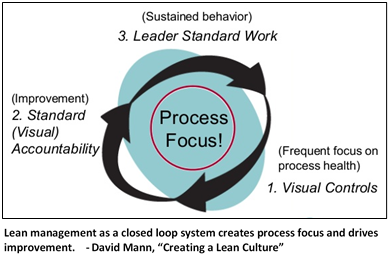 Three years ago I wrote a post entitled “The Emperor’s New Huddle Boards,” in which I expressed concern about the trappings of improvement without actual improvement. Since then, my concern about the application of Leader Standard Work and Gemba Walks has deepened as these potentially valuable practices have too often degenerated into obligatory scripted play acting.
Three years ago I wrote a post entitled “The Emperor’s New Huddle Boards,” in which I expressed concern about the trappings of improvement without actual improvement. Since then, my concern about the application of Leader Standard Work and Gemba Walks has deepened as these potentially valuable practices have too often degenerated into obligatory scripted play acting.
Ten years ago, when I first heard David Mann presenting these concepts, I thought to myself, “Hmm, it’s about time that someone gives thought to the best use of manager’s time in support of kaizen.”
Most managers, in my opinion, needed some guidelines in this regard. A hesitancy to go to the floor for direct observation was a pervasive manager shortfall. Many persons who have viewed GBMP’s video, Toast Kaizen, may not know that in fact, its genesis was in trying to persuade senior managers to get out of their offices and go to the floor to observe. So the idea of establishing a standard that included visits to the Gemba was appealing to me.
Unfortunately, good ideas are sometimes unintentionally abstracted to the point that they become pointless. For each of the three parts of David Mann’s model, I have observed a proliferation of shortcomings that invalidate the intended Lean management system. For the next three weeks, I’ll cover these one-by-one.
Today it’s Visual Controls:
Call me old school, but I grew up in a factory where visual controls mainly meant building visual information directly into the work. For example:
- A standardized work chart posted at the workstation so an observer could compare the actual process with the standard.
- A production-activity log in the production cell, updated on each work cycle with particular emphasis on problems that occurred so that problems could be fixed instantly.
- A visualization of standard work in process, for example, a chute that held only four pieces – no more or less – to clarify the balance of operations.
- An Andon that, if flashing, signaled an immediate need for production support.
When I was a kid, the opportunities like these to build information directly into the process in a low-tech way seemed endless. They provided excellent opportunities for workers to share information about their work, and a manager who understood these visual devices could understand the health of the process at glance.
Today I see far less visual information at the point of use. It’s been replaced by ubiquitous huddle boards and kiosks and video displays, often situated on a wall far from the actual work. The ideal of “frequent focus on the process” has been become an infrequent focus on visual displays updated once per day just before the huddle meeting. The ability to visually compare actual to standard has been lost. Recently, in fact, I visited an organization that proudly announced they were replacing all manual huddle boards with digital displays that could be viewed remotely. I’m sorry if this seems harsh, but when these types of standalone visual devices become the sole standard for visual controls, managers learn little or nothing about the Gemba. “Grasping the current condition” is replaced by counting the red and green dots. One manager announced to me that he could tell the condition of the factory merely by glancing at the huddle board for several seconds. “No,” I responded, “you can only tell the condition of the huddle board.”
One final rhetorical question regarding the red and green dots: In an environment where reviewing a huddle board is understood to be going to the Gemba, how many red dots would you expect to see? A colleague related to me a comment he received from a shop floor employee. “Have you heard of the color watermelon?” the employee asked, and then answered. “We have watermelon dots on our huddle board. They’re green on the outside, but red on the inside.”
In fact, I do think huddle boards and kiosk displays can be an impactful part of a visual factory or office; but they are only a piece, and probably not the most important piece. And as stand-alones, they create an additive activity that makes management’s visits to the floor a standardized waste of time and an insult to the front line.
O.L.D.
PS Did this get you hot under the collar? Then please add a comment. And watch for the continuation of this post next week when I’ll be sharing some concerns about the second part of the Lean Management System: Accountability.
BTW For a terrific story from one senior leader who understands management’s role to create a transparent workplace that incorporates visualization of the work, I recommend Jim Lancaster’s The Work of Management. Or better still, sign up for our 14th Annual Northeast Lean Conference to be held in Providence on October 10-11, 2018 and hear Jim Lancaster’s Lantech story directly from him at his October 11 conference keynote.

 Three years ago I wrote a post entitled “
Three years ago I wrote a post entitled “